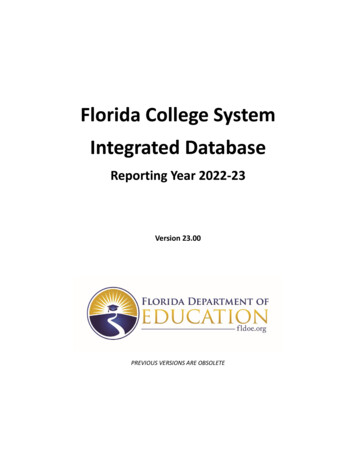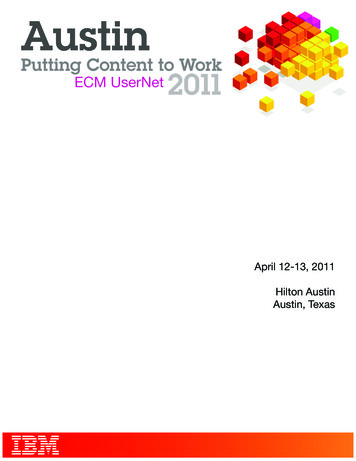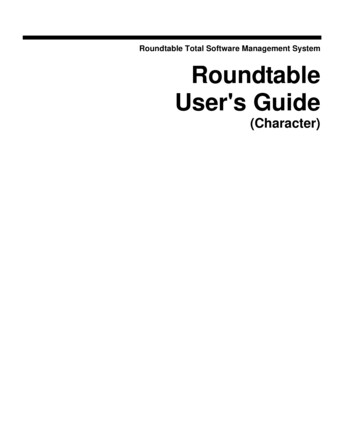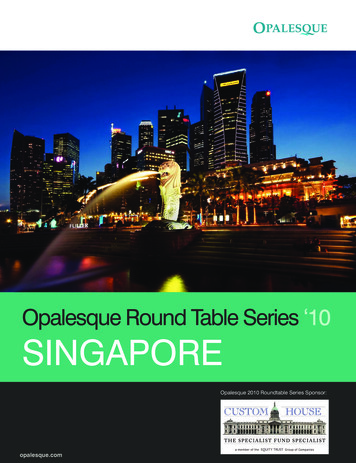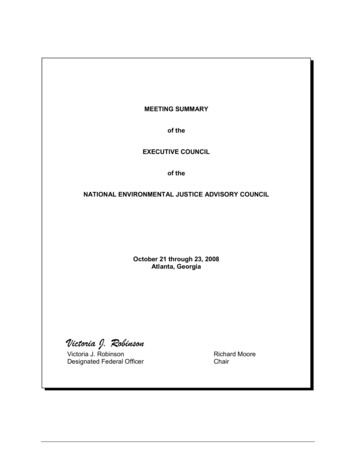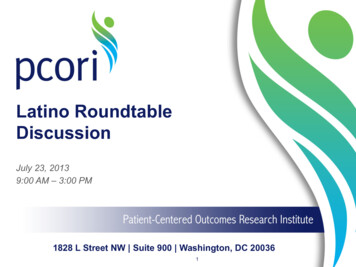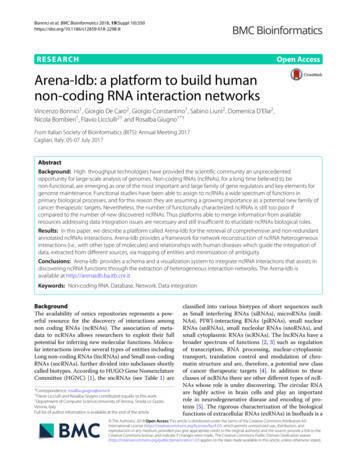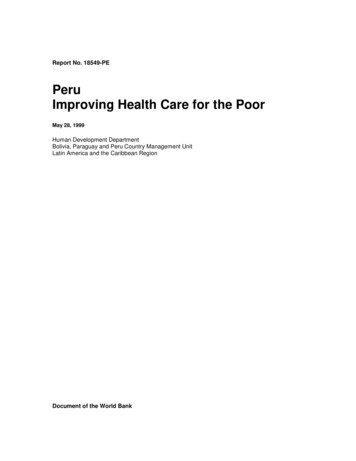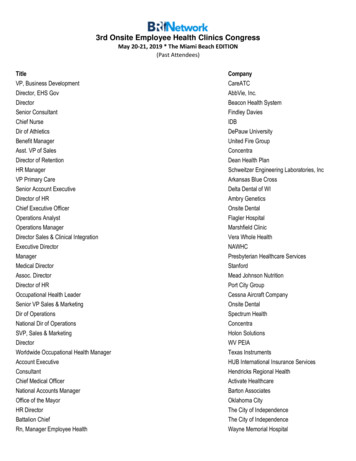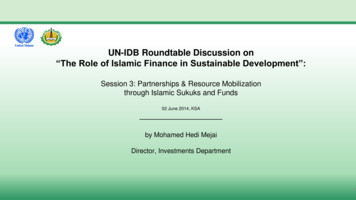
Transcription
UN-IDB Roundtable Discussion on“The Role of Islamic Finance in Sustainable Development”:Session 3: Partnerships & Resource Mobilizationthrough Islamic Sukuks and Funds02 June 2014, KSAby Mohamed Hedi MejaiDirector, Investments Department1
Resource Mobilization is getting an increased attention from MDBs MDBs can no more rely on their equity to fund their operations. The MDB Working Group on Infrastructure report to the G20 in Oct 2011 set ResourceMobilization for Project Preparation as a key objective. How this objective can be achieved?– Developing Countries – shall be encouraged to increase mobilization of resourcesdomesticaly; possibly through PPPs or co-financing schemes.– Donors and MDBs – need to ensure that funding is accompanied by a commensurate amountof human and financial resources for project preparation.– The Private Sector- shall be encouraged to invest in projects that have good prospects ofrecovering their preparation investment by an award of the project. They could also directlyinvest in PPP projects.2
Recent Resource Mobilization efforts by MDBs MDBs set an overall resource mobilization strategy to address the resource gap stemming fromtheir expanding mandate. Two popular financial instruments are increasingly used by MDBs:– Fixed Income Instruments (such as Bonds and sukuks).– Private Equity Funds. Concrete recent examples include the following:– IFC AMC’s that raised USD 6.3 billion in six funds from SWFs, Pension Funds and bilateralDFIs.– IDB that mobilized over USD 7.0 billion from public offerings of Sukuk and USD 3.5 billionthrough funds.– AFDB that mobilized USD112 million in 2013 in funds from 7 donor agencies.3
What is a Sukuk? Sukuk commonly refers to the Islamic equivalent of bonds. However, there is a fundamental difference: Sukuk grants the investor a shareof an asset, along with the commensurate cash flows and risk; While theconventional bond merely confer ownership of a debt whereby the bond holderearns a debt spread. Sukuk securities adhere to Shari’ah principles, which prohibit the charging orpayment of interest. Sukuks are issued for a purpose namely for a specific project or asset.Hence, they are tied to real economy.4
Sukuk is becoming a global phenomena First sukuk programme in Europe was launchedin 2004, through a German federal state ofSaxony-Anhalt. In 2005, the UK issued the region’s firstcorporate sukuk. Increased attraction from sovereign issuers.Some of the ones that are in the pipeline are:– Government of UK– around GBP 323.4 million.– Government of Luxemburg– around EUR 271.7million.– Societe Generale – around MYR 300.4 million.5
Sukuk is a thriving business As of 1Q 2014, Total global Sukukissuance scored USD32.9 billion, anincrease of 13.8% over 1Q 2013. Sovereign issues accounted for 63% interms of capital raised, Corporate 24%and Quasi Sovereign 12%.
Sukuks in Infrastructure Projects is by far the largest Between 2001 and 2013, a total of USD84.3bln worth of infrastructure sukuks havebeen issued by more than 10 differentcountries. Examples of projects include:– GACA Sukuk in Saudi Arabia of size USD4.06 billion to finance expansions of AbdulAziz International Airport (KAIA) in Jeddahand King Khalid International Airport (KKIA)in Riyadh.– GEMS Education in Dubai of size USD 200million to finance expansion plans.– Kuala Lumpur International Airport 2Expansion of size USD 0.3 billion in 1sttranche and USD 0.5 billion in 2nd tranche –partnership between Government ofMalaysia &Malaysia Airport Holding Berhad.
IDB is a market maker for Sukuks IsDB has demonstrated its commitment to the Sukuk market by regularlytapping into the public markets for the past six years (2004-2014), today aboutUSD 7 billions of issuance. There is increased demand for IDB sukuks from institutions outside the regionBreakdown by Investor TypeFundManagers, 9%CB &GovtAgencies, 49%as around 49% come from Asian & European countries. Although most issuances are USD denominated, IDB utilized privateplacement for sukuks in other currencies such as GBP, EUR and MYR.Banks,42%Central Banks & Government Agencies are the biggestsubscribers to IDB’s sukukIslamicInvestorN/A,s, 7%17%NonIslamicInvestors, 76%Subscribers are not forcibly Islamic Investors8
Challenges in SukuksDespite the progress made, there are still improvements to be made: High Administrative Costs – related to setting up SPVs, need to obtain rating from internationalrating agencies. Legal risks- mainly associated with bankruptcy laws, shariah compliance and regulatory clarity onissues conflicting between civil law and shariah law. Currencies Hedging – related to available shariah compliant methods related to swappingissuance proceeds into other currencies. Identifying projects to deploy sukuk proceeds – unlike conventional bonds, sukuks are issuedfor a purpose and this has to be specifically known in advance before final issuance of a sukuk.9
Opportunities in Infrastructure Sukuks Amount of Islamic Liquid Resources – sovereign wealth funds (SWFs) originating from Islamiccountries could be invited to invest in Shari’a compliant infrastructure funds. The investor demand forinfrastructure projects, especially in the wake of the region’s economic recovery, remains strong and isexpected to grow further, seeing that most institutional investors still have not met their targetallocations to infrastructure as an asset class. Increased awareness and participation from conventional & non-Islamic investors - emergingeconomies may not be able to depend on infrastructure financing from the advanced economies, asmuch as they have in the past. This opens up opportunities for the sukuk market, as a mechanism toattract investors who are interested in Shari’a compliant products. Demand for Infrastructure Projects– For instance: in GCC, the total volume of infrastructure projects projected from 2010-2014 is USD 4tln.– In Europe, the total volume of infrastructure projected to meet Europe’ 2020 objectives is about EUR2 tln.10
Private Equity Funds as Resource Mobilizing tool Private Equity (PE) Funds are becoming a verypopular tool for Multilateral Development Banksintervention. PE Funds provide MDBs with a tool to mobilizefunds off-balance sheet.MDBs Investments in PE Funds (2012)500450435400350 By Investing in PE Funds, MDBs can be a catalystto mobilize resources from private institutionalinvestors. However, most of MDBs processes and mindsetare not yet aligned with PE market practice.Some already established dedicated assetmanagement companies to increase the volumeof PE fund activity and align their processes tothe PE market practice.300250200Number 1
Overview of Islamic Funds Market Islamic Funds industry is in its early stages, however it hasillustrated steady growth. Total AuM has grown at a steady CAGR of 7.33% from 2007to 2012. In terms of Geographical focus Islamic Funds have had aglobal focus, with 27% of AuM invested globally.12
IDB’s financing of infrastructure is one of its key pillars for development IDB has approved investments in infrastructure withan equivalent size of USD 3.29 billion.SubSaharan5%Geographic DistributionInvestments in Power, Water, TransportInfrastructure and Industrial amounted for more than50% of total investments in Infrastructure.While more than 50% is invested in the Middle East,IDB’s investment span across many regions inAfrica, and in 2%TransportInfrastructure15%Sectoral ExposureIndustrial6%Power &Water30%LOF8%Mining24%Petroleum&chemicals17%13
IDB Infrastructure FundsIDB Infrastructure Fund I: Launched in 2001, The IDB Infrastructure Fund was the first private equity investment vehicle to focus oninfrastructure development in Member Countries of the Islamic Development Bank. The fund had commitments of USD 730 Million, and invested almost USD 600 million in 10 projects in 9different countries. The fund returned an IRR of 19% with 1.75 multiple.IDB-ADB Islamic Infrastructure Fund: Launched in 2009, this fund was a partnership with ADB to make shariah complaint infrastructure investmentsin Asia. The fund raised about USD 250 million and targets the 12 Asian countries that are members in both IDB andADB.IDB Infrastructure Fund II: Launched in May 2014, this fund is a follow up to the first fund.The Fund has raise USD 850 million and is aiming for a target size of US 2 Billion.The fund will target Shariah complaint investments in Infrastructure Projects in IDB member countries.14
Challenges of Islamic Private Equity Funds Some markets do not have the regulatory framework to address Islamic finance. Challenges in deployment of resources due to limited shariah complaints deals. Limited exit options in non developed capital markets. Lack of Islamic hedging instruments.15
Opportunities of Islamic Private Equity Funds The essence of Islamic finance is to grow the economy by sharing risk and building businesses based on realtransactions and real assets. In this sense, private equity truly is a perfect ethical fit. Islamic PE Market is growing fast and reaching a mature stage. There is a growing attention with an explosion of fund managers and steady increase in the number of fund. Islamic PE Funds can access funds and investors that might not be accessible conventional funds. With the massive gap in infrastructure needs in the developing countries Islamic PE Funds provides yetanother option to mobilize resources.16
Concluding Take Away Points Islamic Finance has the capacity to bring additional resources for sustainable development for the followingreasons:– Availability of liquidity– There is absorption capacity in particular to finance infrastructure– Is widely accepted as a financial instrument– By being asset backed, Islamic finance is closely linked to the real economy. And hence real development17
Thank you18
tapping into the public markets for the past six years (2004-2014), today about USD 7 billions of issuance. Fund There is increased demand for IDB sukuks from institutions outside the region as around 49% come from Asian & European countries. Although most issuances are USD denominated, IDB utilized private
